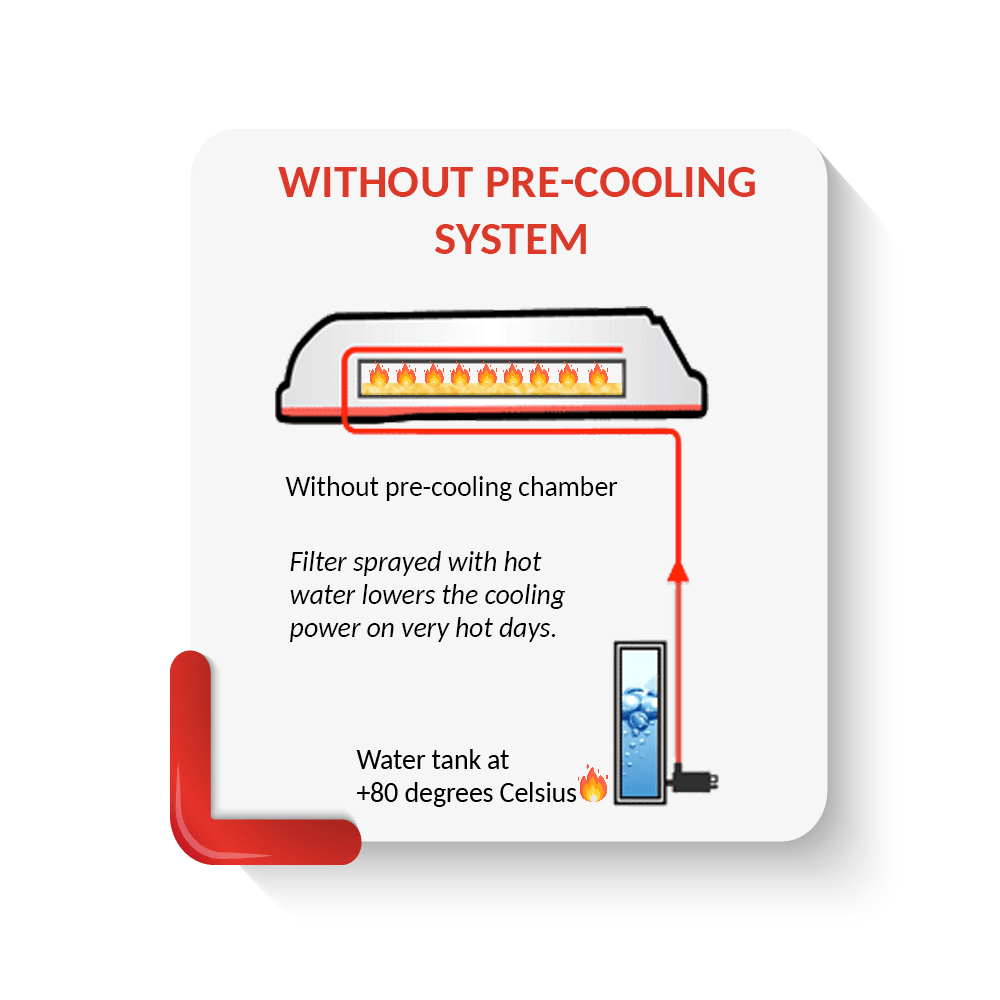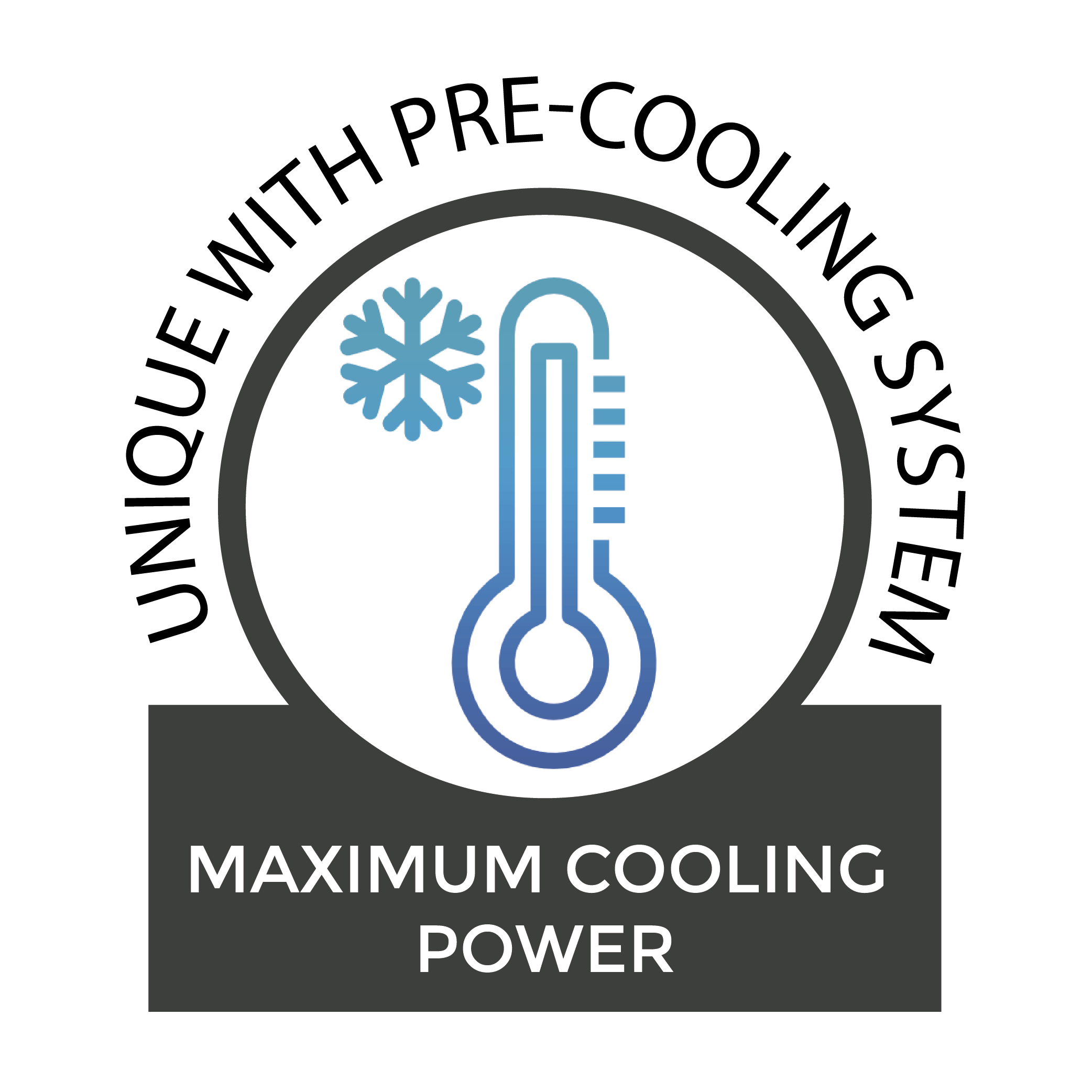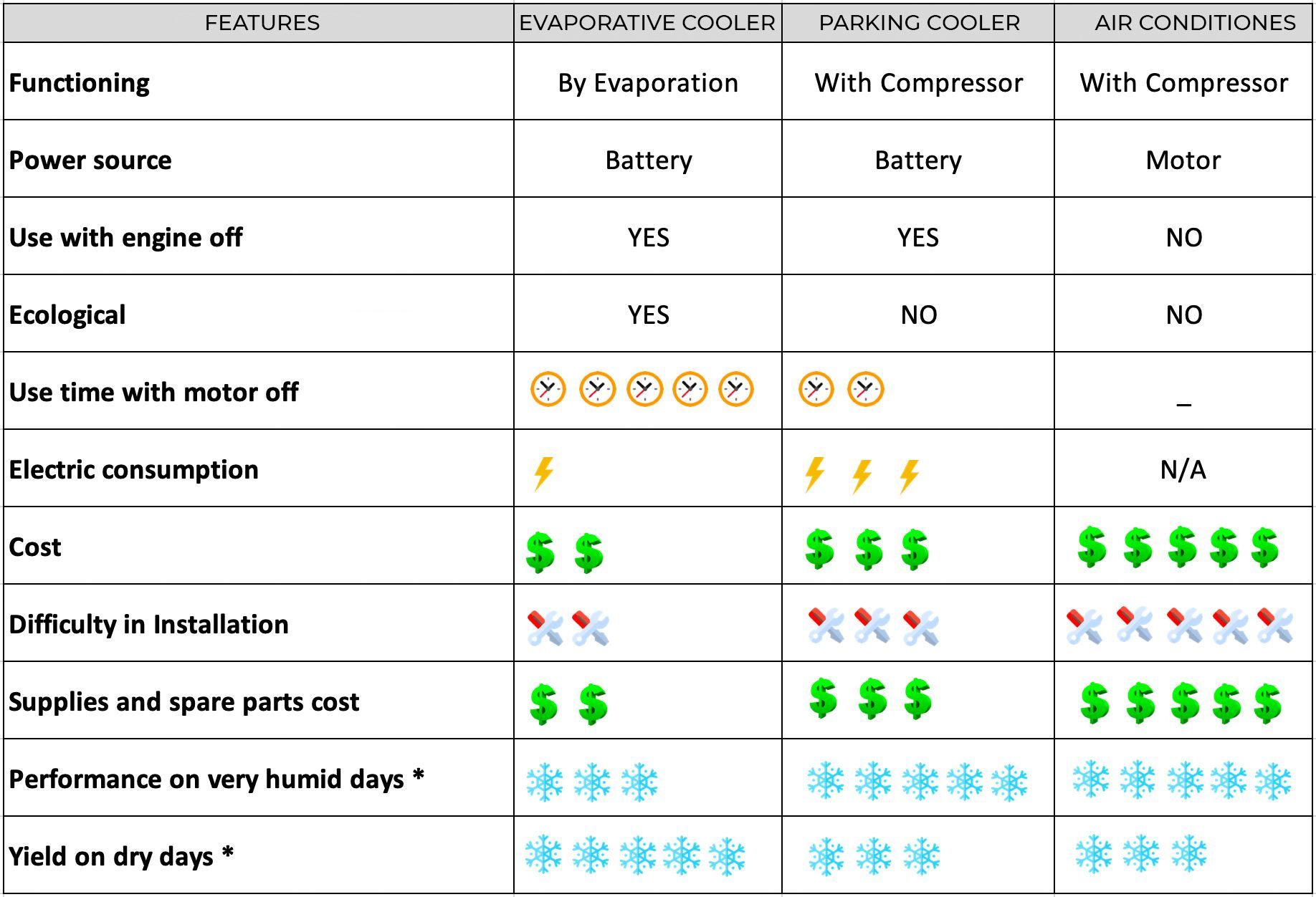how does an evaporative cooler work?
An evaporative cooler collects air from the outside and forces it through a filter with water. Inside this filter, the water evaporates and in the process absorbs the heat from the air. Once cold, air enters the vehicle cabin maintaining a fresh environment for its occupants.
This system is 100% natural, consumes very little electricity and always renews the air inside the vehicle.
Natural cold and low energy consumption
The evaporative cooler is a natural air conditioner. It works by the evaporation principle, it does not produce CO2 emissions and reduces the emission of greenhouse gases.
As when humans sweat, evaporation will always have a cooling effect. During the process of evaporation, liquid molecules are converted to vapors which then disappear from the surface. When the vapors disappear, heat energy is removed from the surface. The wind increases the effects of evaporative cooling, and this is one of the reasons evaporative coolers contain blowers. This is because it drives the evaporation rate up, making the cooler more effective.
Unlike an air conditioner, an Evaporative Cooler has a very low electrical consumption (maximum 7amp x hour in 12v) and it is connected directly to the vehicle’s battery.
An evaporative cooler:
- Does NOT consume fuel
- It is VERY easy to install
- Can be used with the vehicle parked
- Can be used with the engine off
- DOES NOT use engine power
Where are Evaporative Coolers Most Effective?
They work best in dry and hot climates, such as desert areas of the United States and in Europe. This is because the coolers incorporate moisture into the air. This means that they would not be very effective in humid climates where there is already an excess of moisture in the air.
The dry air absorbs the moisture, cooling the air as a result. It is important to keep the relative humidity levels in your vehicle below 50%. This refers to the quantity of water vapor in the air relative to how much the maximum capacity the air can hold at any given temperature.
You can know the humidity of your Area (selecting «Relative Humidity» in the menu on the left): USA or Europe: USA or Europe
What are the Benefits of Evaporative Coolers?
Evaporative coolers are very energy efficient and release hardly any emissions. This makes them a much more eco-friendly option. They do not use any chemical refrigerants which could damage the environment.
The extra humidity that they release into the air can make dry climates easier to live in. They can relieve sore throats, dry skin, and itchy eyes caused by dry air.
How Does a Neil Evaporative Cooler Work?
The water pump is placed inside the vehicle’s water tank. This pump sends water to the pre-cooling chamber inside the evaporative cooler when it needs it.

When the pre-cooling chamber is full, the humidifying pump begins to operate, which carries the water from the pre-cooling chamber to the wet filter saturating it fully in water.
The blower motor then forces the blower to turn. This pulls warm air from the environment into the cooler, through the wet filter. As the warm air is pulled through, the moisture in the wet filter cleans, purifies, and cools it.
The wet filter also add water molecules to the air, making it less dry.
The blower then forces the now cooled air out of the evaporative cooler. It is pushed through the ductwork in your vehicle.
How much does a Neil Evaporative Cooler cool?
The performance of an evaporative cooler will depend on the ambient relative humidity and the outside temperature. The higher the temperature and the lower the humidity, the greater the performance of the evaporative cooler.
The following chart shows the temperature at which the air will come out of the evaporative cooler depending on the outside temperature and the relative humidity. It consists of a horizontal Air Temperature X-axis and vertical Relative Humidity Y-axis that’s communicated in percentage. Air temperature starts at 82 and stops at 115 while humidity is usually covered from around 10% to 80%.
Where these values intersect, you have the meat of the chart with the air supply temperature figures, the figures you can expect from your evaporative cooler when it’s operational. The span of possible temperatures here differs depending on the air temperature and the humidity.
These charts are intended to find the sweet spot for evaporative coolers, where they operate at maximum efficiency have the most appreciable effect on their environment.

What is the Pre-Cooling System?
In many vehicles, the water tank of the evaporative cooler is exposed to the sun and high temperatures. For this reason, the water inside it heats up reaching more than 75 °C (167 °F).
If the evaporative cooler filter is soaked with hot water, the cooler reduces its efficiency and loses utility. Many users add ice to the water tank, which alleviates the situation for only a few minutes.
The Pre-Cooling System (patented by Neil) offers a Solution. This system separates the temperature of the external tank from the water temperature with which the filter is humidified, achieving optimum performance even when the water in the external tank is above 80 °C (176 °F).


Natural cold and low energy consumption
This innovative patented system, present only in Neil Evaporative Coolers, is revolutionizing evaporative coolers in Argentina, Brazil and Europe, as it guarantees maximum cooling power, even when the water in the tank is above 80 °C (176 °F).

– The Pre-Cooling chamber keeps 1 liter of water always cold (24 °C / 75 °F ), with which the humidifying filter is sprayed.
– The same operation of the evaporative cooler keeps the water in the Pre-Cooling chamber at around 24 °C ( 75 °F).
– As needed, hot water (over 80 °C / 176 °F) from the external tank is sent to the Pre-Cooling chamber.
– Upon contact with cold water, hot water is immediately cooled.
– This continuous cycle allows the filter to always be moistened with cold water, even when the tank water exceeds 80 °C (176 °F)
Evaporative Cooler, Parking Cooler or Air Conditioner?
Currently there are different technologies that allow maintaining a comfortable environment inside a vehicle. Each of them has advantages and disadvantages.
Evaporative Cooler: These work exclusively with water and their energy consumption is Minimum. It is the most efficient way of keeping the interior of a vehicle nice and cool.
Parking Cooler: These are air conditioners that connect to the vehicle’s battery. These have a similar performance to a home’s air conditioner with the exception that these can only work between 1 and 3 hours with the engine off, since it has a very high electrical consumption.
Air Conditioners: These work with a compressor that is directly connected to the vehicle’s engine, so it ONLY works when the engine is on. When it does not come from the factory with the vehicle, its installation is usually very complex and expensive.

